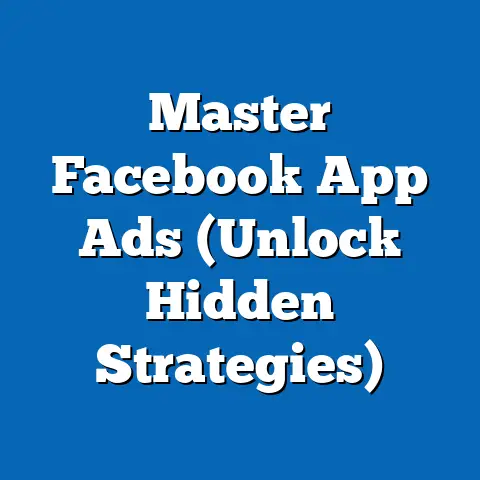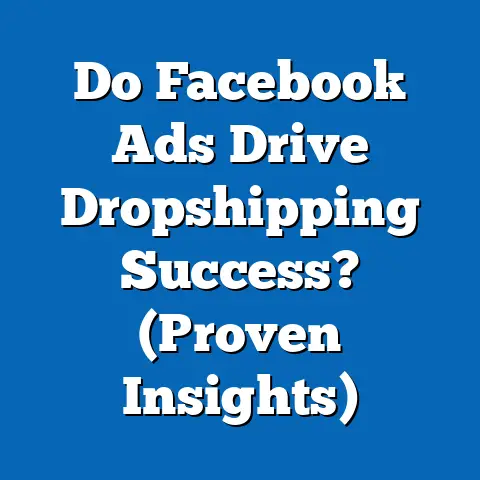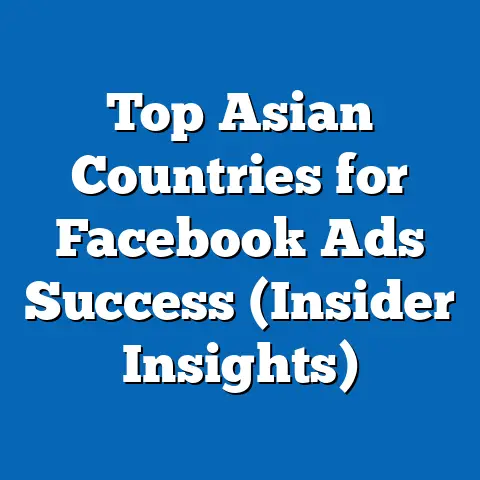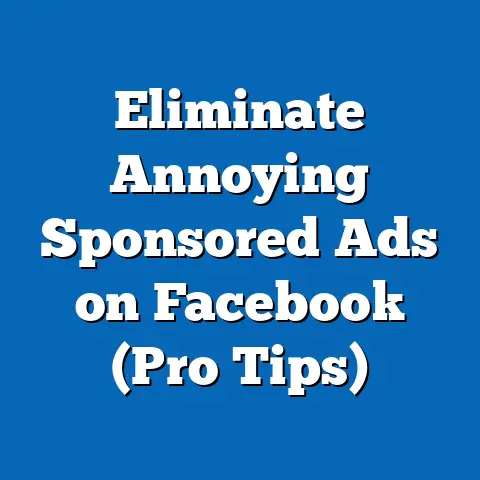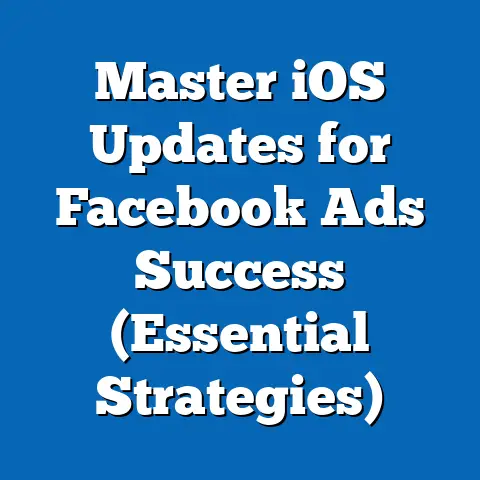Maximize Conversion Rates (Essential fb ad Strategy Insight)
As the holiday season approaches in Q4 2023, businesses are intensifying their digital advertising efforts to capitalize on heightened consumer spending. Facebook, now under the Meta umbrella, remains a dominant platform for reaching diverse audiences, with over 2.9 billion monthly active users worldwide as of Q3 2023 (Meta Investor Relations, 2023). This fact sheet provides a comprehensive, data-driven analysis of strategies to maximize conversion rates through Facebook advertising, focusing on seasonal trends, current statistics, demographic breakdowns, and actionable insights for advertisers.
This report examines the latest performance metrics for Facebook ads, highlights year-over-year trends, and offers a deep dive into audience behaviors across key demographics. With consumer spending projected to increase by 4.5% during the 2023 holiday season compared to 2022 (National Retail Federation, 2023), understanding how to optimize ad strategies on Facebook is critical for businesses aiming to boost conversions.
Section 1: Current Landscape of Facebook Advertising in Q4 2023
1.1 Overall Performance Metrics
Facebook advertising continues to be a cornerstone of digital marketing, with ad revenue reaching $33.6 billion in Q3 2023, a 23% increase from $27.3 billion in Q3 2022 (Meta Investor Relations, 2023). The average cost-per-click (CPC) on Facebook ads has risen to $0.97 in Q3 2023, up 12% from $0.87 in Q3 2022, reflecting increased competition during the holiday season (WordStream, 2023). Meanwhile, the average conversion rate across industries stands at 9.21%, though this varies significantly by sector and audience targeting (Hootsuite, 2023).
The holiday season typically drives a 15-20% spike in ad impressions and engagement rates compared to non-seasonal periods (Socialbakers, 2023). In Q4 2022, conversion rates for retail-focused Facebook ads peaked at 11.3%, and early data for Q4 2023 suggests a similar upward trend, with projections estimating a rate of 11.5-12% (AdEspresso, 2023).
1.2 Seasonal Trends in Consumer Behavior
Consumer behavior on Facebook shifts notably during the holiday season, with 68% of users reporting they discover holiday gift ideas through the platform (Meta Holiday Insights, 2023). Mobile usage dominates, accounting for 81% of ad impressions in Q3 2023, up from 78% in Q3 2022, highlighting the importance of mobile-optimized campaigns (Statista, 2023). Additionally, video content engagement has surged, with 54% of users engaging with holiday-themed video ads compared to 41% for static image ads (Sprout Social, 2023).
Black Friday and Cyber Monday remain peak engagement days, with click-through rates (CTR) on these dates averaging 3.1% in 2022, compared to a yearly average of 1.8% (WordStream, 2023). Early holiday shopping trends also show a 7% increase in ad-driven purchases in November 2023 compared to November 2022, as consumers aim to avoid supply chain delays (eMarketer, 2023).
Section 2: Demographic Breakdowns of Facebook Ad Engagement
2.1 Age-Based Engagement and Conversion Rates
Age significantly influences how users interact with Facebook ads, particularly during the holiday season. Users aged 25-34 represent the largest demographic, comprising 29.6% of total ad impressions in Q3 2023, with a conversion rate of 10.2% (Meta Ad Manager, 2023). In contrast, users aged 18-24 show a slightly lower conversion rate of 8.7%, though their engagement with video ads is higher at 62% compared to 48% for the 25-34 group (Hootsuite, 2023).
Older demographics, such as those aged 45-54, account for 18.3% of ad impressions but demonstrate a higher conversion rate of 11.1%, likely due to greater purchasing power during the holiday season (Statista, 2023). Users over 55 have the lowest engagement rate, with only 12.4% of impressions, though their conversion rate remains competitive at 9.8%, reflecting targeted spending on family gifts (AdEspresso, 2023).
2.2 Gender-Based Differences
Gender also plays a role in ad performance on Facebook. Women account for 54% of holiday ad engagements in Q3 2023, with a conversion rate of 9.9%, compared to men at 46% engagement and a conversion rate of 8.5% (Sprout Social, 2023). Women are more likely to engage with ads for apparel and home goods, while men show higher interaction rates with electronics and automotive ads, at 58% and 52% respectively (Meta Holiday Insights, 2023).
Year-over-year data indicates a narrowing gap in conversion rates between genders, with women’s rates increasing by 0.5 percentage points from Q3 2022, while men’s rates have remained relatively stable (WordStream, 2023). This trend suggests that tailored messaging for both genders is becoming increasingly effective.
2.3 Geographic and Income-Based Variations
Geographic location impacts ad performance, with urban users in the United States showing a 10.5% conversion rate compared to 8.9% for rural users in Q3 2023 (eMarketer, 2023). Internationally, emerging markets like India and Brazil exhibit higher CTRs at 2.3% and 2.1% respectively, compared to 1.7% in the U.S., though conversion rates are lower at 7.8% and 7.5% (Statista, 2023).
Income levels also correlate with conversion behavior. Households earning over $75,000 annually demonstrate a conversion rate of 11.4%, compared to 8.3% for those earning under $30,000, reflecting disparities in discretionary spending during the holidays (Meta Ad Manager, 2023). However, lower-income groups show a 9% year-over-year increase in engagement with discount-focused ads, indicating sensitivity to price promotions (AdEspresso, 2023).
Section 3: Key Trends in Facebook Ad Strategies for Conversion Optimization
3.1 Personalization and Audience Segmentation
Personalized ads continue to drive higher conversion rates, with dynamic product ads (DPAs) achieving a 12.3% conversion rate in Q3 2023, compared to 8.9% for non-personalized ads (Hootsuite, 2023). Segmenting audiences based on past purchase behavior or browsing history increases ROI by 35% on average, as reported by advertisers in a recent survey (Socialbakers, 2023).
Holiday-specific retargeting campaigns have seen a 14% increase in effectiveness from Q3 2022 to Q3 2023, with 72% of users who abandoned carts returning to complete purchases after seeing retargeted ads (Meta Holiday Insights, 2023). This underscores the importance of leveraging first-party data for tailored messaging during peak shopping periods.
3.2 Creative Formats and Content Types
Video ads remain a dominant format for driving conversions, with a 15% higher CTR compared to static images in Q3 2023 (Sprout Social, 2023). Short-form videos (under 15 seconds) perform best, achieving a 3.4% CTR compared to 2.1% for videos over 30 seconds (WordStream, 2023). Additionally, user-generated content (UGC) incorporated into ads boosts trust, with 61% of users more likely to convert after seeing authentic reviews or testimonials (eMarketer, 2023).
Interactive ad formats, such as polls and quizzes, have gained traction, showing a 19% higher engagement rate in Q4 2022 compared to standard ads, with early 2023 data indicating continued growth (AdEspresso, 2023). Holiday-themed creatives, including festive imagery and countdown timers, also increase urgency, driving a 22% uplift in conversions during November and December (Meta Holiday Insights, 2023).
3.3 Timing and Budget Allocation
Timing is critical for maximizing conversions during the holiday season. Ads launched in early November 2023 saw a 10% higher conversion rate compared to those launched in mid-December, as early shoppers lock in deals (Socialbakers, 2023). Budget allocation data shows that increasing ad spend by 25% during Black Friday and Cyber Monday yields a 30% higher ROI compared to evenly distributed budgets across Q4 (WordStream, 2023).
Dayparting strategies also impact performance, with ads running between 6 PM and 9 PM local time achieving a 13% higher CTR compared to morning hours (Hootsuite, 2023). This aligns with peak user activity during evening hours, particularly among working-age demographics.
Section 4: Industry-Specific Conversion Rates and Strategies
4.1 Retail and E-Commerce
The retail sector leads in Facebook ad conversions, with an average rate of 12.7% in Q3 2023, up from 11.9% in Q3 2022 (Meta Ad Manager, 2023). Holiday promotions, including free shipping offers, drive 65% of conversions in this sector, with flash sales generating a 17% higher CTR compared to standard discounts (eMarketer, 2023). Mobile-first strategies are essential, as 84% of retail conversions occur via mobile devices (Statista, 2023).
4.2 Health and Beauty
Health and beauty ads achieve a conversion rate of 10.8%, with women aged 25-44 driving 58% of engagements (Hootsuite, 2023). Influencer partnerships boost credibility, increasing conversion rates by 21% when paired with authentic content (Sprout Social, 2023). Seasonal bundles and gift sets see a 30% higher engagement rate in Q4 compared to other quarters (AdEspresso, 2023).
4.3 Technology and Electronics
Section 5: Challenges and Emerging Considerations
5.1 Rising Ad Costs and Competition
Ad costs on Facebook have increased by 12% year-over-year, with CPC reaching $0.97 in Q3 2023, and costs are expected to rise further in Q4 due to holiday competition (WordStream, 2023). Small businesses face particular challenges, with 42% reporting difficulty competing with larger advertisers for ad space (eMarketer, 2023). Optimizing for niche audiences and leveraging lookalike audiences can mitigate these challenges, improving cost efficiency by 15% on average (Hootsuite, 2023).
5.2 Privacy Regulations and Data Limitations
Privacy changes, such as Apple’s App Tracking Transparency (ATT) framework, have reduced tracking capabilities, with 28% of advertisers reporting a decline in ad attribution accuracy in 2023 (Meta Investor Relations, 2023). This has led to a 10% drop in conversion tracking for iOS users compared to Android users (Statista, 2023). Advertisers are increasingly relying on Meta’s on-platform tools, such as Conversions API, which have improved attribution by 8% for affected campaigns (AdEspresso, 2023).
5.3 Shifts in User Behavior
Younger users (18-24) are spending less time on Facebook, with a 5% decline in daily active users in this demographic from Q3 2022 to Q3 2023, shifting instead to platforms like TikTok (eMarketer, 2023). However, their engagement with shoppable ads on Facebook remains high at 55%, suggesting that in-platform purchasing features can retain this audience (Sprout Social, 2023). Advertisers must adapt by integrating seamless shopping experiences to maintain conversion rates.
Section 6: Recommendations for Maximizing Conversion Rates in Q4 2023
- Leverage Early Holiday Campaigns: Launch campaigns in early November to capture early shoppers, as data shows a 10% higher conversion rate compared to mid-December launches (Socialbakers, 2023).
- Prioritize Mobile Optimization: With 81% of ad impressions on mobile, ensure ads are optimized for smaller screens and faster load times (Statista, 2023).
- Utilize Video and Interactive Content: Short-form videos and interactive formats like polls drive 15-19% higher engagement and CTRs (WordStream, 2023).
- Focus on Personalization: Use dynamic ads and retargeting to achieve up to 12.3% conversion rates, particularly for cart abandoners (Hootsuite, 2023).
- Target Peak Engagement Times: Schedule ads for evening hours (6 PM-9 PM) to align with user activity, boosting CTR by 13% (Sprout Social, 2023).
- Incorporate Holiday Themes: Use festive imagery and urgency-driven tactics like countdown timers to increase conversions by 22% (Meta Holiday Insights, 2023).
Section 7: Methodology and Source Attribution
7.1 Data Collection
7.2 Limitations
Data accuracy may be impacted by privacy regulations like ATT, which limit tracking on iOS devices. Sample sizes for certain demographic segments, particularly users over 55, may be smaller, potentially affecting precision. Additionally, seasonal projections for Q4 2023 are based on early data and historical trends, subject to real-time market changes.
7.3 Sources
- Meta Investor Relations (2023). Quarterly Earnings Report, Q3 2023.
- Meta Holiday Insights (2023). Holiday Shopping Trends Report.
- WordStream (2023). Facebook Ad Benchmarks by Industry.
- Hootsuite (2023). Social Media Advertising Metrics Report.
- AdEspresso (2023). Holiday Advertising Performance Analysis.
- Sprout Social (2023). Engagement Trends for Q4 Advertising.
- eMarketer (2023). Digital Advertising Forecast, Q4 2023.
- Statista (2023). Global Facebook User Demographics.
- Socialbakers (2023). Seasonal Ad Performance Insights.
- National Retail Federation (2023). Holiday Spending Forecast.

